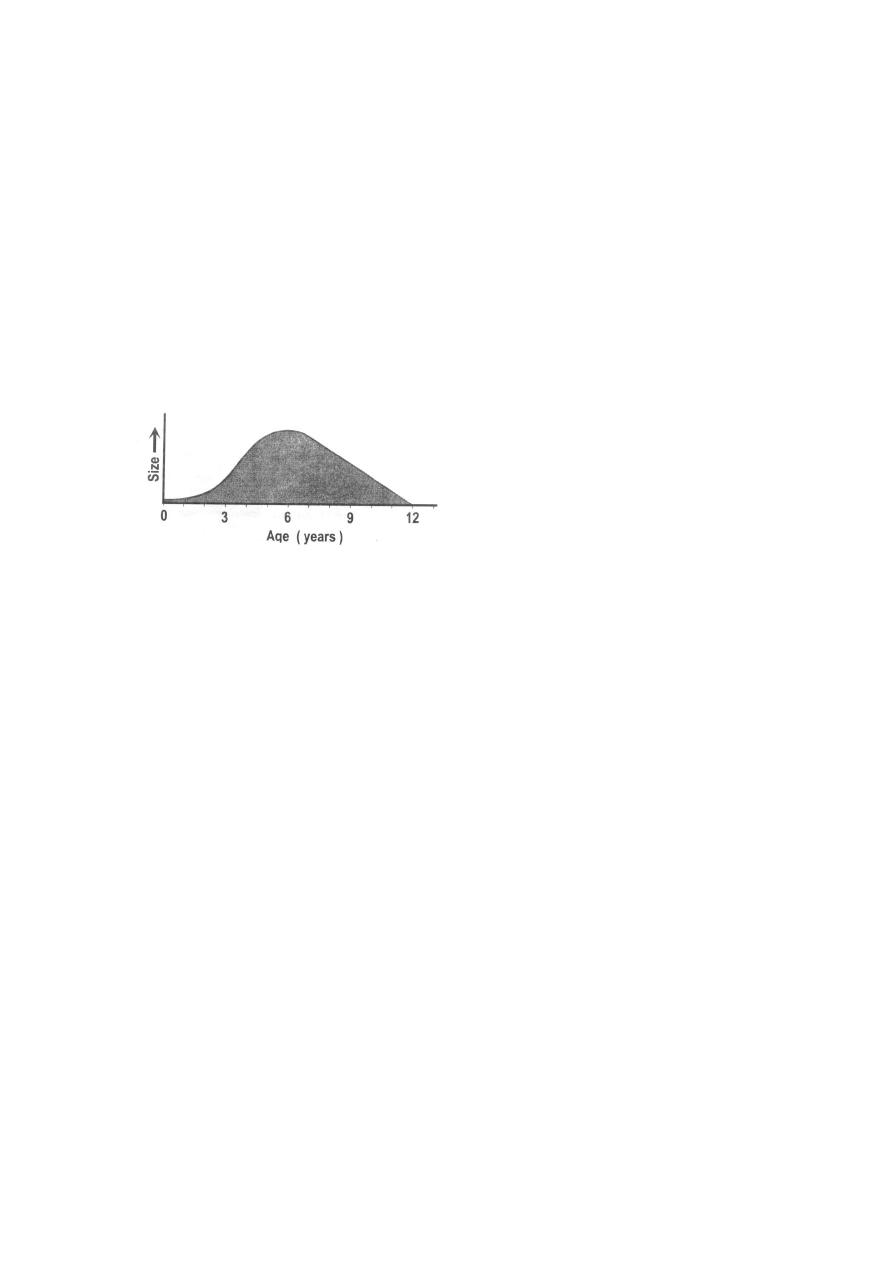
1
Lecture (3) pharynx Dr. Sa'ad Y. Sulaiman
The Adenoid
The nasopharyngeal tonsil, commonly called "adenoids", is situated at the
junction of the roof and posterior wall of the nasopharynx. It is composed
of vertical ridges of lymphoid tissue separated by deep clefts and covered
by ciliated columnar epithelium. Unlike palatine tonsil, adenoids have no
crypts and no capsule. Adenoid tissue present at birth, shows
physiological enlargement up to the age of six years, and then tends to
atrophy at puberty and almost completely disappeared by the age of 20.
Acute adenoiditis
It is acute inflammation of the adenoid tissue. It may occur alone or in
association with rhinitis or tonsillitis. It produces pain behind the nose,
postnasal discharge, nasal block and feeding difficulties in babies.
Treatment is usually medical.
Adenoid enlargement (Adenoid hypertrophy)
AETIOLOGY:
1- Physiological hypertrophy: Occurs at the age of 3 - 8 years and
produced from relative disproportion in size between the adenoids
and the cavity of the nasopharynx.
2- Pathological hypertrophy: Due to recurrent upper respiratory
infections.
SYMPTOMS:
1- Bilateral nasal obstruction :
Mouth breathing.
Speech hypo-nasality (Rhinolalia clausa).

2
Difficult suckling in infants. Noisy respiration (snoring) and wet
bubbly nose may be present.
Snoring and obstructive sleep apnea.
2-Bilateral nasal discharge :
Mucoid or muco-purulent due to mechanical obstruction of the
choanae.
Excoriation of the nasal vestibule and upper lip.
Post-nasal discharge may result in nocturnal cough, laryngismus
stridulus and gastro-intestinal disturbances as loss of appetite and
morning vomiting.
SIGNS:
1- Posterior rhinoscopy => shows the adenoids, but is difficult to be
performed in children.
2- Flexible fiberoptic endoscope is of great help to visualize the adenoid
in the postnasal space.
INVESTIGATION:
Lateral plain x-ray of the nasopharynx: A soft tissue shadow narrowing
the airway => diagnostic.
COMPLICATIONS:
1- Obstructive sleep apnea:
defined as a cessation of ventilation despite
effort for 10 seconds in older children, or 6 seconds in younger infants.
This may affect the patient in the following way:
a) During sleep; restless sleep (due to fragmentation of sleep by frequent
arousal) night mares and nocturnal enuresis.
b) During day time => morning headache, impaired concentration, poor
school performance, excessive daytime sleepiness (due to fragmentation
of sleep)
2- Descending infections:
Ear: Recurrent acute otitis media and secretory otitis media.
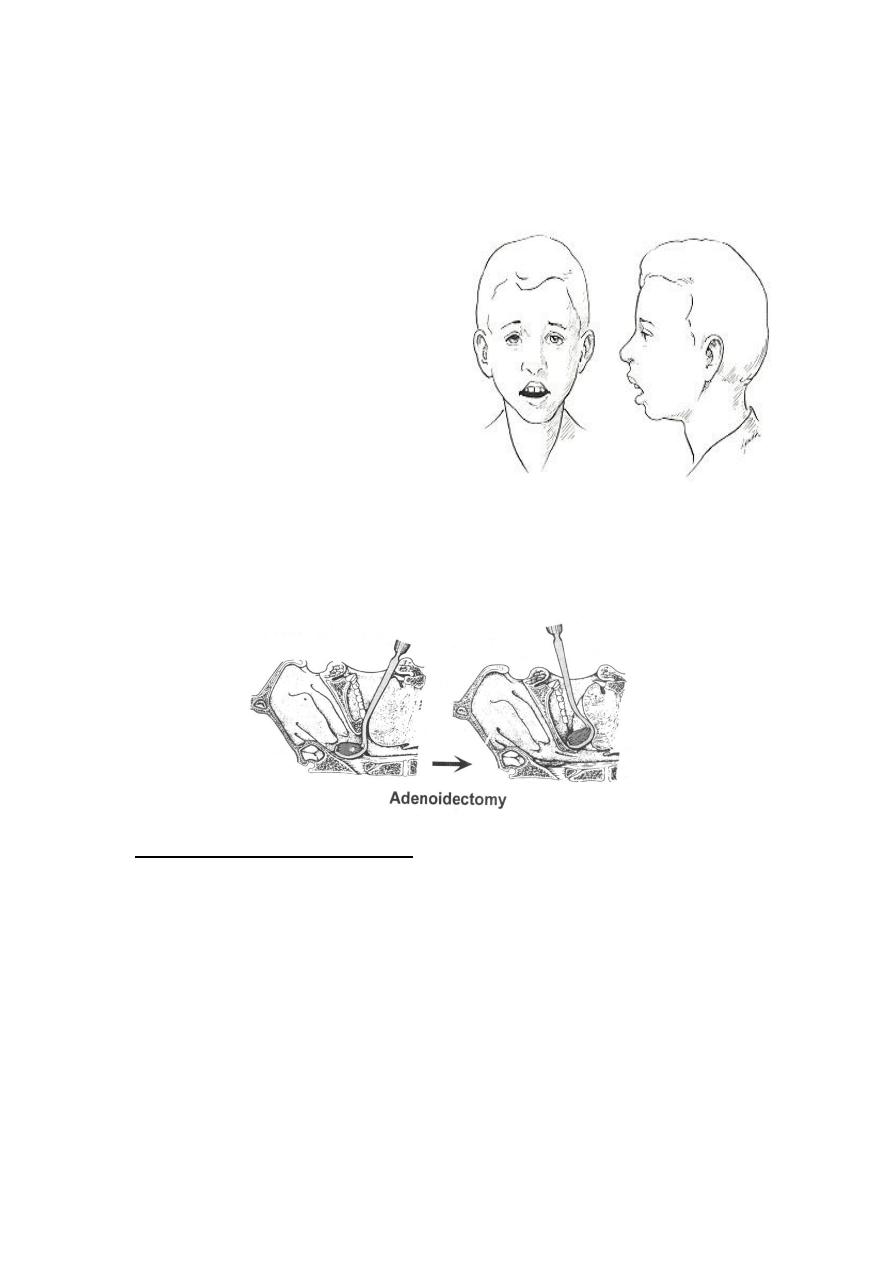
3
Respiratory: Recurrent rhinitis, sinusitis, pharyngitis, laryngitis and
bronchitis
3- Adenoids facies: Due to
under-development of the middle
1/3 of the face
a) Nose: Pinched nostril's
b) Mouth: Open mouth, short
upper
lip,
protruding
upper
incisors, high arched palate and
receding mandible
c) Face: Idiot expressionless
look.
TREATMENT:
Adenoidectomy operation => when adenoids are symptomatic or
complicated.
Adenoidectomy is indicated in:
1. Upper airway obstruction causing sleep apnoea.
2. Chronic nasopharyngitis refractory to medical treatment.
3. Chronic or recurrent middle ear infection.
4. Secretory otitis media.
5. Chronic sinusitis.

4
ACUTE TONSILLITIS
DEFINITION:
Acute inflammation of the palatine tonsils.
INCIDENCE:
Age: Any, but much more common in children.
AETIOLOGY:
Causative organisms: The most common organisms are:
1- Viral:
It has been stated that it is a viral infection of the tonsils that
predisposes to a bacterial infection.
On the other hand a virus may be the
sole agent responsible (e.g.Epstein-Barr virus, Adenoviruses and Herpes
simplex ).
2- Streptococci (Group A Beta-hemolytic).
3- Staphylococci.
4- Haemophilus influenzae.
5- Pneumococci.
6- Anaerobes.
Mode of transmission: Droplet infection.
SYMPTOMS:
General symptoms: Rapid onset of fever ( up to 40 degree), headache,
anorexia and malaise. There is often abdominal pain due to a
mesenteric adenitis.
Pharyngeal symptoms:
a) Rapid onset of dysphagia with severe sore throat and referred
otalgia
b) Bad mouth odour (halitosis).
SIGNS:
1. General signs: High fever and flushed face. Febrile convulsions may
occur in children.
2. Pharyngeal signs:
a) Acute parenchymatous tonsillitis: Marked hyperaemia and enlargement of
the tonsils
b) Acute follicular tonsillitis: The crypts are full of purulent exudates. The
surface of the tonsil has yellowish spots characteristic spotted appearance

5
c) Acute membranous tonsillitis: These yellowish spots may coalesce =>
form a non-adherent yellowish true membrane
3. The tongue is furred and the breath is offensive.
4. Cervical signs: Enlarged tender jugulo-digastric lymph nodes (just below
the angle of the mandible).
Differential diagnosis:
1- Simple acute pharyngitis.
2- Infectious Mononucleosis (glandular fever),a systemic infection caused
by Epstein Barr virus, diagnosed with blood test (monospot test). The
administration of ampicillin may result in the eruption of skin rash.
Spleenomegaly may present in 50% of patients.
3- Scarlet fever. There is skin rash and strawberry tongue.
4- Diphtheria.
5- Ulcerative gingivitis.
6- Agranulocytosis.
COMPLICATIONS:
1. Local complications:
a) Pharyngeal suppurations --> peri-tonsillar abscess, para-pharyngeal
abscess and retro-pharyngeal abscess.
b) Laryngitis
c) Otitis media
2. Systemic complications:
Rare and almost confined to childhood.
a) Rheumatic fever => carditis and arthritis.
b) Acute glomerulo-nephritis.
How? They are due to an auto-immune reaction i.e. the antibodies produced
against Streptococcus beta-haemolyticus cross-react with the patient's own
tissues
c) Septicaemia.
TREATMENT:
1. Antibiotics therapy for 10 days to avoid recurrence.
Penicillin is still the antibiotic of choice either orally, intramuscularly
or intervenously.
Be aware of penicillin-resistance and give alternatives e.g. co-
amoxiclave, cephalosporin ±metronidasole.
Erythromycins were penicillin allergy
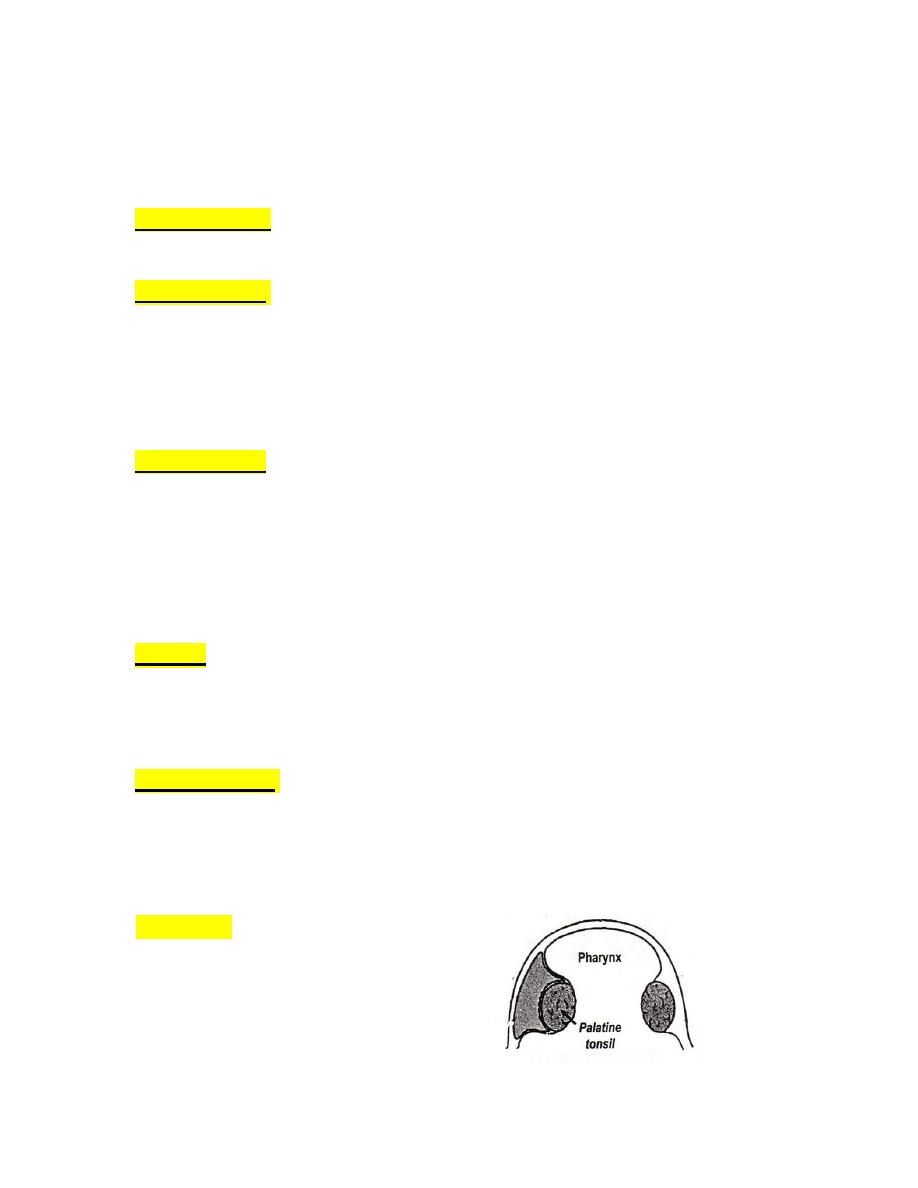
6
2. Supportive and symptomatic measures =>bed rest, generous fluid intake,
analgesics, antipyretics and gargles.
Chronic Tonsillitis
DEFINITION:
Chronic inflammation of the palatine tonsils.
AETIOLOGY:
It follows acute and subacute tonsillitis and is more common in children
between the ages of 4-15 years. The predisposing factors are:
1. Organism factor: Repeated attacks of acute tonsillitis.
2. Treatment factor: inadequate dose or short course of antibiotics therapy.
3. Patient factor: Low patient's resistance e.g. malnutrition.
SYMPTOMS:
1. History of repeated attacks of acute tonsillitis.
2. Sense of throat irritation => frequent hawking and hemming to clear the
throat.
3. Bad mouth odour ( halitosis ) => due to accumulation of pus in the crypts
4. Difficulty in swallowing; if hypertrophic.
5. Snoring and obstructive sleep apnea --> if hypertrophic.
SIGNS:
Persistent enlargement of the jugulo-digastric lymph nodes
Marked tonsillar enlargement with congested anterior pillars.
Squeezing: The crypts ooze pus on pressure by a tongue depressor
TREATMENT:
Tonsillectomy operation; when chronic tonsillitis is symptomatic
Peritonsillar abscess (Quinsy)
Collection of pus in
Definition:
the peri-tonsillar space which is a
connective tissue space that lies
between the tonsil capsule and its
bed (superior constrictor muscle).
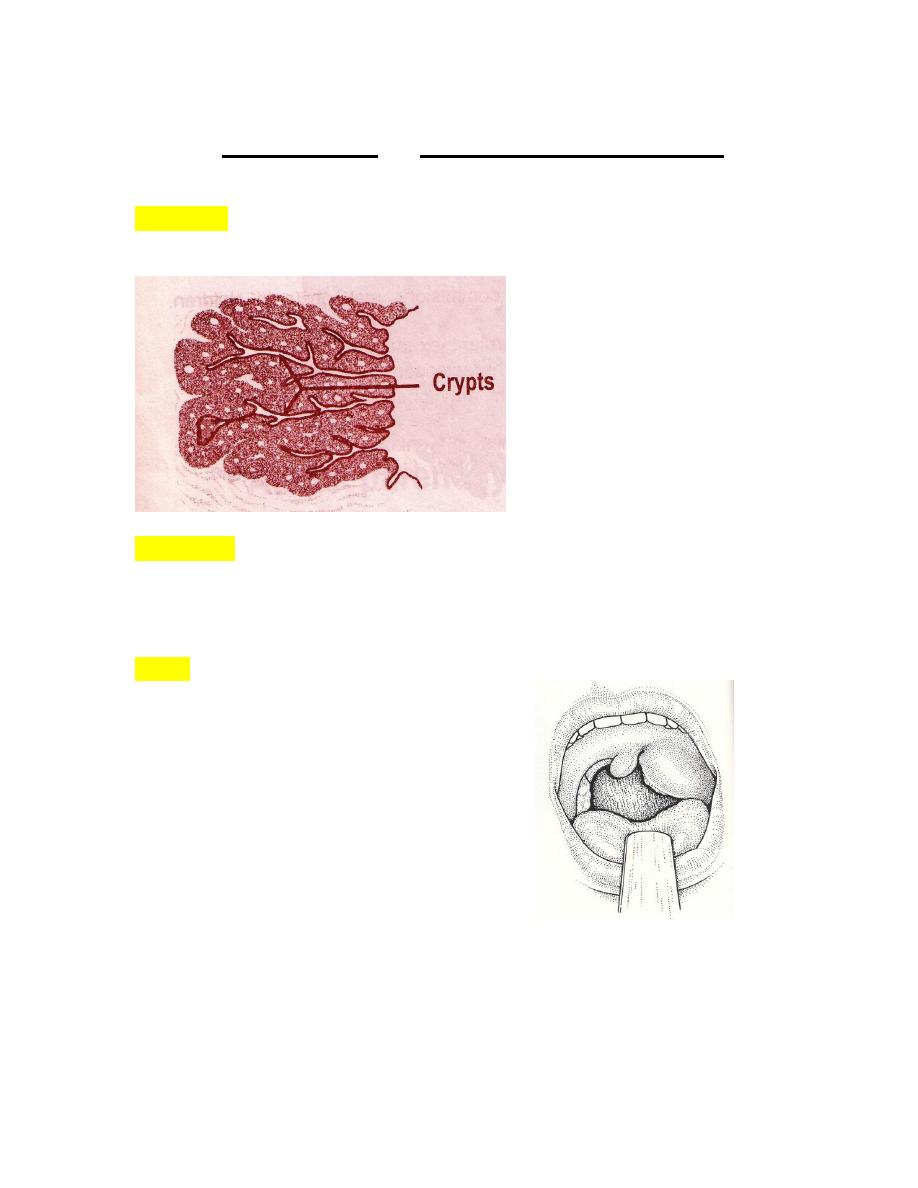
7
The swelling can extend to the softpalate and push the tonsil medially.
Quinsy is usually unilateral and most frequently affects adult males.
Aetiology: In patient with acute tonsillitis, the infection may passe through
crypta magna (the largest tonsillar crypt) towards the peri-tonsillar space.
Symptoms:
Quinsy usually follows acute tonsillitis. The patient looks ill with fever and
may be rigor. There is acute pain in the throat radiating to the ear, and this
makes swallowing so difficult that saliva dribbles from the mouth.
Signs:
The
examination
may
be
difficult because of marked
trismus due to reflex muscle
spasm.
In the affected side, the palate
is edematous and bulging; the
uvula is edematous, pushed to
the other side and
the tonsil is
pushed
downwards
and
medially may have pus on its
surface.
The cervical nodes are enlarged
and tender.
Uvula
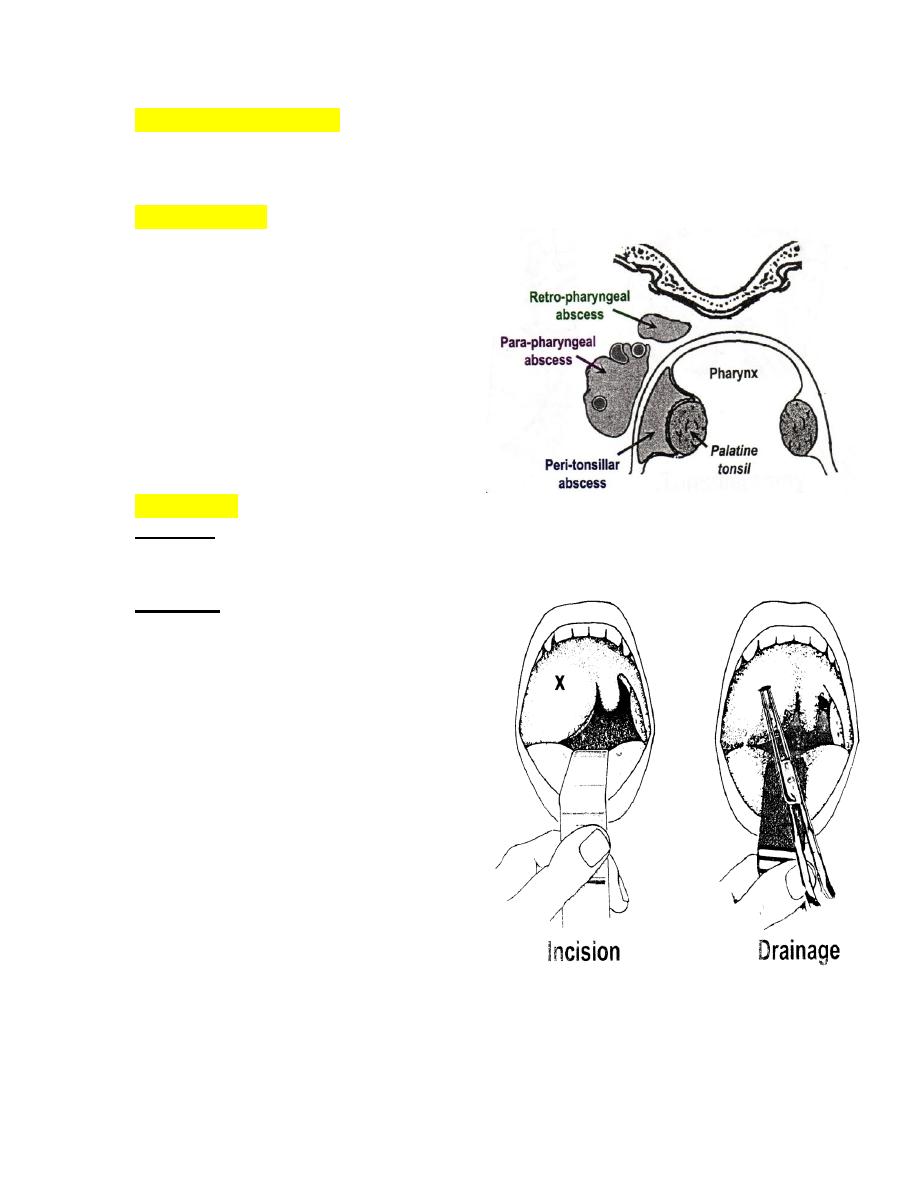
8
Differential Diagnosis:
1. Dental abscess of the upper molar tooth.
2. Parapharyngeal swelling.
Complications
Parapharyngeal abscess
Laryngeal edema
Rupture with aspiration of pus
broncho-pneumonia.
Tonsils should be removed 6-8
weeks following quinsy.
Treatment:
Medical: with massive paranteral
antibiotic therapy e.g. pinicllin or
licomycin.
Surgical: if there is failure of
medical treatment after 24-48 hr.:
- Drainage of the abscess: The
throat is sprayed with local
anesthetic to reduce the trismus,
then aspiration is done with a
wide-bore needle from the most
prominent part of the swelling. If
pus came out, it is sent for culture
and a long sinus forceps is plunged
into the same area and pus is
drained.
Rapid
improvement
follows but antibiotic should be
continued
until
resolution
is
complete.
Tonsillectomy is indicated after 4-6
weeks to avoid recurrence.

9
Tonsillectomy
Indications for tonsillectomy:
The indications for tonsillectomy are subject of controversy: No universal
agreement on the indication for tonsillectomy:
1. Recurrent attacks of acute tonsillitis which is frequent and severe enough
to interfere with the patient's general health (5-6 attacks per year for at
least 2 years).
2. Peritonsillar abscess (quinsy).
3. Sleep apnea syndrome: such children have tonsils, which meat in the
mid-line and cause gross difficulty in breathing.
4. Tonsillectomy for biopsy purposes when the tonsils are thought to be the
site of neoplasm.
5. Diphtheria carriers.
6. Recurrent attacks of otitis media.
7. Acute rheumatic fever and acute nephritis if streptococcus tonsillitis has
been responsible for recurrence.
Contraindication for tonsillectomy:
1. Bleeding disorders on cloning problems.
2. Acutely inflamed tonsils and recent upper respiratory tract infection.
Here it's safer to wait 3 weeks because of greatly increased risk of
postoperative haemorrhage and pulmonary complications respectively.
3. Epidemic of poliomyelitis: There is evidence that the virus may gain
access to the exposed nerve sheaths and so give rise to the more fatal
bulbar form of the disease.
4. Cleft palate because tonsillectomy leads to scarring of soft palate which
affects repair and speech.

11
Postoperative care:
1. Careful monitoring of vital signs. So that any haemorrhage can be
detected.
2. Analgesics: paracetamol. Aspirin should be avoided due to its effect on
coagulation process.
3. Encourage the patient to move the muscles of the throat by swallowing,
talking and drinking. The movement will help in shedding of the slough
from the tonsillar fossae allowing healing to take place.
4. The patient should be warned that referred otalgia may be a predominate
complaint following tonsillectomy.
Complications of tonsillectomy:
1. Haemorrhage:
A. Primary haemorrhage: occurs at the time of operation. It's due to
recent infection, previous quinsy or scarring. It's controlled by
ligation or diathermy. Excessive bleeding from both fossae raise the
question of coagulation defect. Here blood transfusion may be
necessary.
B. Reactionary haemorrhage: occur within few hours after the operation.
It's due to inadequate haemostasis at the time of operation, rise of
blood pressure, reopening of vessels or due to slipping of ligatures.
It's treated by preparing a blood and early return to the theatre where
the vessel is ligated.
C. Secondary haemorrhage: occur 5-8 days after operation. It's due to
infection, often associated with a refusal of the patient to eat or an
upper respiratory tract infection at time of surgery. The patient should
be readmitted to the hospital and a course of antibiotics is ordered.
2. Trauma: capped or carious teeth are at risk during tonsillectomy.
Insertion of the mouth gag can lead to dislocation of the TMJ.
3. Infection: Pyrexia is not uncommon at the morning after tonsillectomy.
Prolongation of the pyrexia is a sign of infection which if not treated lead
to secondary haemorrhage.
4. Otitis media: It should be distinguished from referred otalgia.

11
5. Chest complications: It's more likely to occur if the patient has an URTI
at the time of operation or due to inhalation of blood or broken tooth.
6. Pain: it's common in adult especially in the first week till the slough
separates.
Other Diseases Affecting The Oropharynx
Plummer Vinson (Paterson Kelly) Syndrome
A chronic atrophic type of inflammation of the mucous membrane of the
mouth, pharynx and upper end of esophagus.
The major changes occur in the postcricoid region initially started by
fissuring and hyperkeratosis followed by fibrosis, web formation and
stricture.
The condition may be associated with achlorhydria and/or splenomegally.
A small proportion of patients with this condition progress to the stage of
postcricoid cancer.
Aetiology
It is unknown but autoimmune and metabolic basis are presumed.
Clinical Picture
The disease is more common in females usually over 40 years:
Dysphagia and feeling of a lump in the throat.
Pallor due to iron deficiency anemia.
Angular stomatitis.
Dryness of the tongue because of glossitis.
Koilonychia.
Loss of weight
Investigations:
Hematological:
- CBP: hypochromic microcytic anemia
- Low serum iron
- High iron binding capacity.
Ba-Swallow: web at the postcricoid region or upper esophagus.
Esophagoscopy: Fissuring, hyperkeratosis followed by fibrosis and web
formation.
Treatment
Correction of anemia by iron and vitamin B complex in high doses.
Endoscopic resection of the web to relieve dysphagia and exclude
malignancy (by histopathological examination).

12
Keep the patient under observation because malignant changes can still
occur.
Globus Pharyngeus (Globus Hystericus)
Sensation of lump in the throat affecting mainly middle aged females, which
is brought on or made worse by anxiety.
Aetiology
The condition is often regarded as functional in which no organic cause can
be found.
Recently the most accepted organic theory is gastroesophageal reflux
diseases (GERD).
Clinical picture
Intermittent sensation of lump in the throat usually felt at or above the
sternal notch, noticed when the patient is swallowing saliva and relieved by
meals!
There is no true dysphagia and no weight loss and the patient often has
psychological stress or cancer phobia.
Diagnosis
The condition should not be diagnosed until an organic lesion has been
excluded in order not to miss an early carcinoma.
Clinical examination is normal.
1. Flexible fiberoptic endoscopy( under local anesthesia) of upper
aerodigestive tract
2. Ba- swallow: may show cricopharyngael spasm
3. Hematological investigations to exclude iron deficiency anemia
Treatment:
1. Reassurance that there is no organic disease or cancer.
2. Antireflux therapy: Omeprazole + Domperidone.
3. Psychiatric consultation is required in selected cases.
4. Remember that: dysphagia + weight loss + pain radiating to the ear +
enlarged neck lymph node= Malignancy is the cause until proven
otherwise!!!
-------------------------------------------------------
--------------------

13
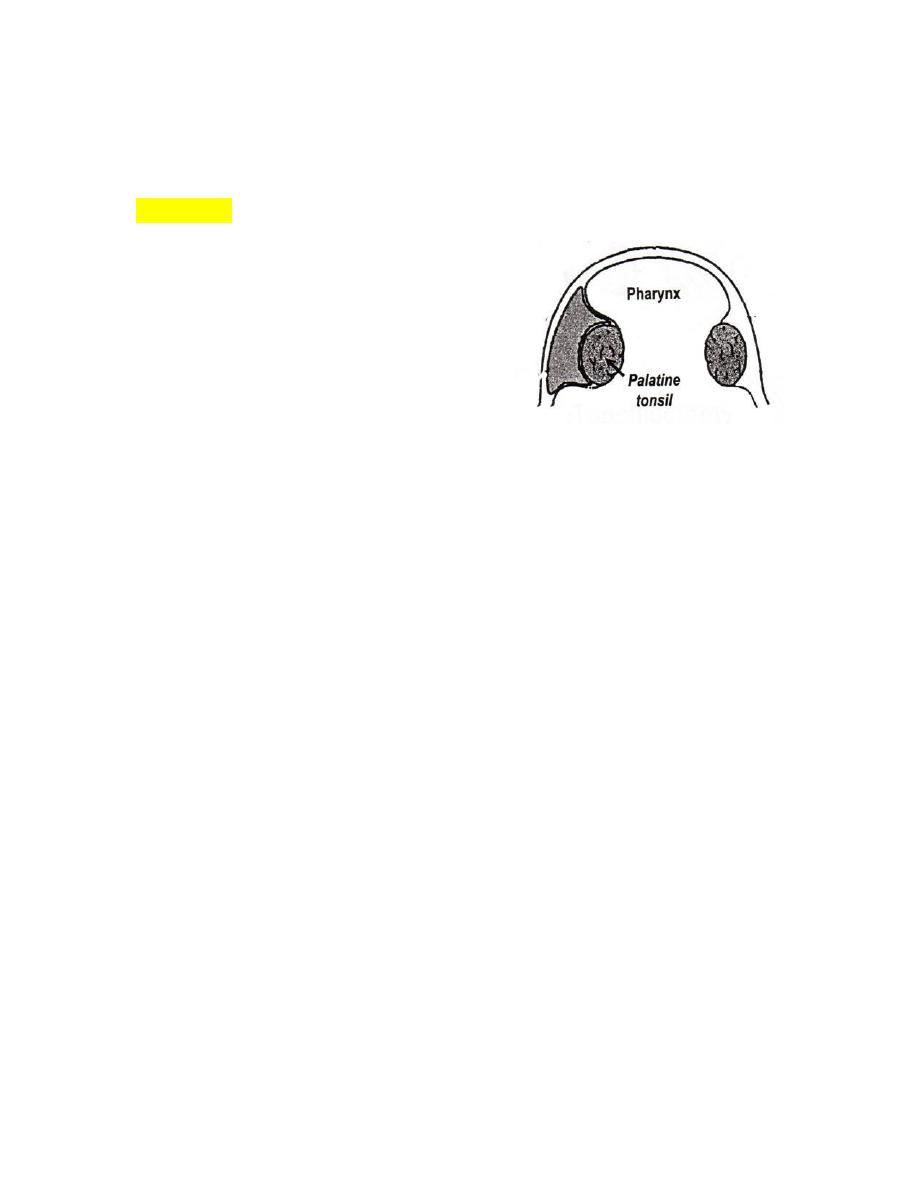
14
Peritonsillar abscess (Quinsy)
Collection of pus in
Definition:
the peri-tonsillar space which is a
connective tissue space that lies
between the tonsil capsule and its
bed (superior constrictor muscle).
The swelling can extend to the soft
palate
and
push
the
tonsil
medially.
Quinsy
is
usually
unilateral and most frequently
affects adult males.

15
